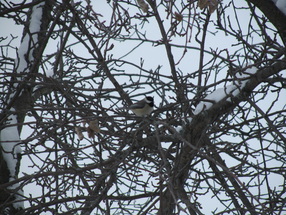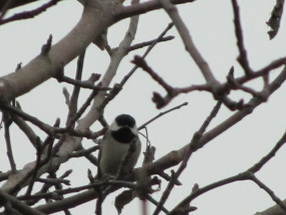Carolina Chickadee
Male: Gray bird with a black cap and throat patch. White chest and tan belly. Dark gray tail.
Female: Same as male.
Diet: Suet, sunflower, safflower, millet, insects, fruit and mixed seeds.
Song: High, fast chick-a-dee-dee-dee and fee-bee-fee-bay.
Nest: Cavity; Female and male build or excavate. Mayl nest in boxes with a 11/4 inch hole.
Eggs: Five to seven; white with reddish brown markings.
Incubation: Eleven to twelve days; female and male incubate.
Fledging: Thirteen to seventeen days; male and female feed young.
Notes: Similar to Black-capped chickadee; best distinction is that the Carolina's song higher and faster version of chick-a-dee-dee-dee. Can be tamed and hand-fed.
Male: Gray bird with a black cap and throat patch. White chest and tan belly. Dark gray tail.
Female: Same as male.
Diet: Suet, sunflower, safflower, millet, insects, fruit and mixed seeds.
Song: High, fast chick-a-dee-dee-dee and fee-bee-fee-bay.
Nest: Cavity; Female and male build or excavate. Mayl nest in boxes with a 11/4 inch hole.
Eggs: Five to seven; white with reddish brown markings.
Incubation: Eleven to twelve days; female and male incubate.
Fledging: Thirteen to seventeen days; male and female feed young.
Notes: Similar to Black-capped chickadee; best distinction is that the Carolina's song higher and faster version of chick-a-dee-dee-dee. Can be tamed and hand-fed.


